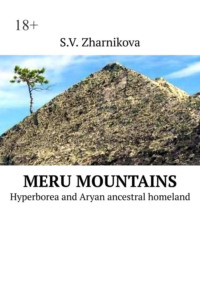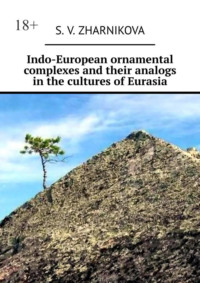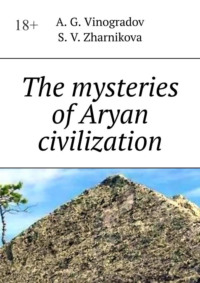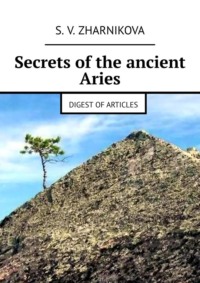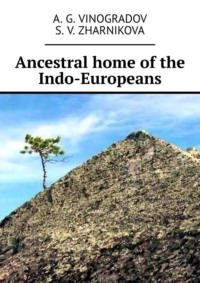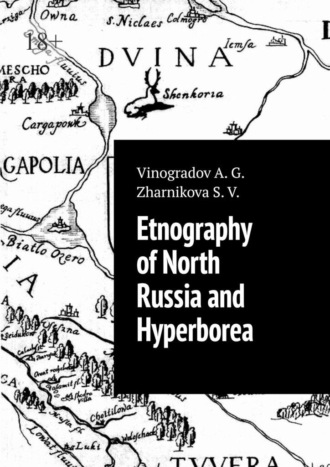
Полная версия
Etnography of North Russia and Hyperborea
After analyzing the «Dictionary of Hydronims of Ukraine», which includes 44 thousand variants of the names of rivers and lakes, and mapping root hydronyms, we compared the resulting area with a map of archaeological cultures for coincidence. A feature of these hydronyms is the presence of a variant in the Russian language presentation (with the optional presence of a Slavic version). (Словник гідронімів Украіни. Киев. Наукова Думка. 1979). The area of hydronyms coincided with the area of the Bug-Dniester culture.
The Bug-Dniester culture is an early Neolithic culture widespread in the Dniester region, tributaries of the Dnieper and in the Bug basin. Dated to the end of the 7th – beginning of the 5th millennium BC (6400 – 5300 BC), was replaced by the Trypillian culture. It should be noted that the pottery ornament of the Bug-Dniester culture resembles the ornament of Vologda embroidery and lace.
This provision corresponds to the instructions of B. A. Rybakov about the beginning of the Slavic historical process: «… the ancestors of the Slavs already from the V – III millennia BC they knew agriculture, experienced a temporary rise in the Eneolithic era, associated with the strengthening of pastoralism, took part in the settlement of vast areas… their economy was based on settled cattle breeding and agriculture with hunting and fishing as additions; they settled in small villages. The main tools were still made of stone, but bronze (chisels, awls, ornaments) was also used.» (Rybakov B. A. Kievan Rus and Russian principalities of the XII – XIII centuries. M. Science. 1982).
An analysis of the hydronyms of the Russian North and adjacent territories revealed about 400 Russian hydronyms without suffixes. The largest percentage of root hydronyms (over 2%) is observed in the following counties: Pechenga 4%, Onezhsk 4%, Kem 3%, Arkhangelsk 3%, Kholmogory 3%, Pinega 3%, Turinsk District 3%, Poshekhonsk 2%, Varnavinsk 2%. In other territories, their percentage ranges from 0% to 2%. The center of the range falls on the White Sea Pomorie, but at the same time there are centers of high importance in the south of the region in the Urals. The central part of the Dvina basin, the watershed of the Dvina and Volga, Vostok are practically not covered by them.
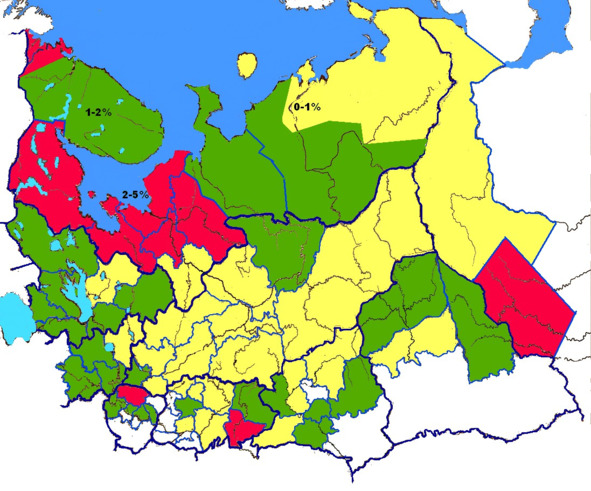
Hydronyms without suffixes %
The situation changes somewhat when the number of root hydronyms is taken into account in certain comparable territories. The largest number of root hydronyms is observed in the following districts: Kem 34, Kola Peninsula 28, Pinezhsk 20, Turinsk District 19, Arkhangelsk 18, Kholmogory 16, Onezhsk 16. There is a clearly defined area along the coast of the White Sea with its center in Kem County.
But it is difficult to say whether this White Sea area is the center of the studied hydronymic type, or, given the presence of a pronounced maximum in the Urals, the area of preservation of the Eneolithic traditions.
In any case, we identify a pre-Slavic language type based on Russian. This conclusion fundamentally contradicts the prevailing opinion about the existence of the Balto-Slavic language, then the Proto-Slavic language and its division into separate Slavic languages, from which the Russian language was then formed in modern times. The picture turns out to be completely different.
«Russia is a country of eternal changes and is not at all conservative, and a country of ultra-conservative customs, where historical times live, and does not part with rituals and ideas, no matter how they relate to it. Modern culture here is an outward gloss, it develops in waves, generates disgusting phenomena; what has been preserved by the ancient tradition in relation to goods, customs, tools, etc., was invented solidly, reasonably, wisely and skillfully… They are not a young people, but an old one – like the Chinese. All their mistakes are not youthful flaws, but stem from asthenic exhaustion. They are very old, ancient, conservatively preserved all the oldest and do not abandon it. By their language, their superstition, their disposition to inheritance, etc. you can study the most ancient times. " (Victor Hen. Biography. 1894).
When analyzing the hydronyms of the Russian North, it should be borne in mind that the hydronyms under study are not the most ancient; we have identified a group of hydronyms that Academician B. A. Rybakov called «preglacial». The linguistic composition of the hydronyms of the North confirms the conclusion of B. A. Rybakov about the autochthonous formation of the Slavic ones.
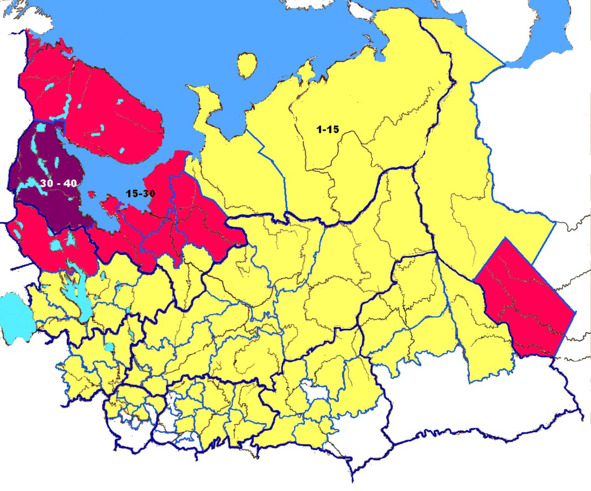
Number of hydronyms without suffixes
Archaic hydronymy and the population of the Russian North in the Eneolithic era
The problem of settling the Slavic population in the north of Europe was discussed in our work «Archaic Slavic ethno and hydronymy and the problem of the Slavicization of the Russian North.» In particular, on the territory of the Russian North, an ancient Slavic hydronymic layer was identified, attributed to the era of the Tshinetsko-Komarovo culture (16—8 centuries BC).
Speaking about the Slavic peoples (alliances of tribes) B. A. Rybakov attributes their formation to two eras: he associates the names of peoples such as «Radimichi» with the later colonization of the 6—7 centuries, and the names such as «glade» with the Trinecko-Komarov culture. «B. V. Gornung speaks even more definitely about the isolation of the Proto-Slavs in the middle of the 2nd millennium BC and directly connects the Proto-Slavs with the Trzhinetsk and Komarov (a more developed version of the Trzyniec) cultures. The vast area of Trzyniecki culture in its final form again revived the idea of the Slavic massif from the Dnieper to the Oder, in full agreement with the latest linguistic data on the time of the separation of the Slavs… Thus, we can recognize the area of the Trzhinets-Komarovo culture as the primary place of unification and formation of the first spun off of the Proto-Slavs, who remained in this space after the grandiose settlement of the Indo-Europeans – the „cords“, calmed down. This area can be denoted by the somewhat vague word „ancestral home“… Let us consider the duration of the historical life of each of the cultures, reflected by three maps: Trzynetsko-Komarovskaya – about 400 years, Przeworsko-Zarubinetskaya – about 400 years, Culture Prague-Korczak – about 200 years. As a result, we get about a thousand years, when the area of a certain ethnic community, reflected on these maps, was a historical reality. We involuntarily have to reckon with this and conform to this reality our research in the field of Slavic ethnogenesis.» (Рыбаков Б. А. Язычество Древних Славян. М. Наука.1981).
«The creation of a homogeneous archaeological (Trinecko-Komarov) culture was the result and material expression of the consolidation process. The Slavism of that time was not absolutely monolithic – a single archaeological culture was subdivided into 10—15 local variants that could correspond to ancient tribes or tribal alliances, and possibly to the primary dialects of the Proto-Slavic language (?). The starting point of reference for the Slavic historical process that we have chosen is the middle of the 2nd millennium BC – finds the Proto-Slavic world at the level of the primitive communal system, but with a fairly rich historical past: the ancestors of the Slavs already from the V – III millennia BC knew agriculture, experienced a temporary rise in the Eneolithic era associated with the strengthening of pastoralism, took part in the settlement of huge spaces and by the time of the crystallization of the Proto-Slavic ethnic group, they had already reached a certain level of culture: their economy was based on settled cattle breeding and agriculture with hunting and fishing as supplements; they settled in small villages. The main tools were also made of stone, but bronze was also used (chisels, awls, ornaments). The separation of the druzhina stratum within the tribe is not documented.» (Рыбаков Б. А. Киевская Русь и русские княжества XII – XIII вв. М. Наука.1982).
V. N. Toporov and O. N. Trubachev point to the extreme conservatism of hydronymic suffixes. On the territory of the settlement of the Slavs, the most ancient names are those in which the suffixes "-n-», "-itsa» are present. (В. Н. Топоров, О. Н. Трубачев. Лингвистический анализ гидронимов Верхнего Поднепровья. Изд. АНССР. М. 1962).
Since the names in which the formant "-itsa» is present appeared clearly later than the names in which the formant "-n-" is present, the names indicated refer to the era of the previous Tszynetsko-Komarov culture, that is, before 1500 BC.
According to B. A. Rybakov is the epoch of 5—3 millennia BC, the time of the Eneolithic – Trypillian culture (dated according to the calibrated radiocarbon chronology 5500—2650 BC).
S. V. Sokolovsky, speaking about topo- and hydronymy as indicators of ethnic areas, notes the need to use the category of toponyms-migrants, «marking the processes of ethnic settlement». As essential features of mass-colonization toponyms, S.V. Sokolovsky calls the disconnection of their etymologies with the names and nicknames of persons, as well as the areality of the topoformants included in their composition. He notes that: «the last feature is the most significant, since it indicates the transfer of not an isolated name, but a toponymic system.» (Соколовский С. В. Роль данных ономастики в историко-антропологических исследованиях. Советская этнография. 1985. №5.).
Конец ознакомительного фрагмента.
Текст предоставлен ООО «Литрес».
Прочитайте эту книгу целиком, купив полную легальную версию на Литрес.
Безопасно оплатить книгу можно банковской картой Visa, MasterCard, Maestro, со счета мобильного телефона, с платежного терминала, в салоне МТС или Связной, через PayPal, WebMoney, Яндекс.Деньги, QIWI Кошелек, бонусными картами или другим удобным Вам способом.




